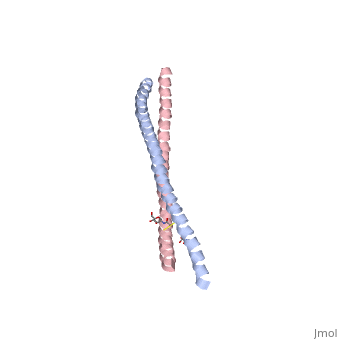Tetherin: Difference between revisions
David Canner (talk | contribs) No edit summary |
Michal Harel (talk | contribs) No edit summary |
||
| (15 intermediate revisions by 2 users not shown) | |||
| Line 1: | Line 1: | ||
<StructureSection load='2xg7' size='350' side='right' scene='' caption='Glycosylated human tetherin ectodomain dimer [[2xg7]]'> | |||
==Tetherin is a membrane-associated protein that may prevent the release of enveloped viruses from their host cells== | ==Tetherin is a membrane-associated protein that may prevent the release of enveloped viruses from their host cells== | ||
While tetherin may be an effective inhibitor of some viruses, other viruses have been shown to produce viral proteins that | |||
'''Tetherin''' or '''bone marrow stromal antigen 2''' (BST-2) has been shown to prevent the release of HIV-1 virions and may be an effective inhibitor of other enveloped viruses as well such as Lassa and Marburg viruses. Tetherin inhibits the release of virions by binding to viral particles budding from the cell membrane, preventing the release of these infectious particles. | |||
The tetherin protein is always found on the surface of B lymphocytes, dendritic cells, and activated T lymphocytes. In brain, kidney, liver, skeletal muscle, pancreas and heart cells. The tetherin gene can be stimulated to be expressed by the production of alpha Interferon, a cytokine. | |||
While tetherin may be an effective inhibitor of some viruses, other viruses have been shown to produce viral proteins that downregulate the production and expression of some cellular proteins, including tetherin. Some strains of HIV-1 as well as Ebola viral particles produce viral proteins shown to downregulate tetherin expression on the surface of the cell membrane. | |||
==Additional Resources== | ==Additional Resources== | ||
*[[Human Immunodeficiency Virus]] <br /> | |||
*[[Viral Infections]] | |||
<br /> | <br /> | ||
</StructureSection> | |||
==3D structures of tetherin== | |||
Updated on {{REVISIONDAY2}}-{{MONTHNAME|{{REVISIONMONTH}}}}-{{REVISIONYEAR}} | |||
[[2x7a]], [[3nwh]], [[2xg7]], [[3mqb]], [[3mqc]] – hBST-2 ectodomain – human<br /> | |||
[[3mq7]], [[3mq9]] - hBST-2 ectodomain (mutant)<br /> | |||
[[2lk9]] – hBST-2 transmembrane (mutant) – NMR<br /> | |||
[[4p6z]] – hBST-2 in adaptor protein complex<br /> | |||
[[6cm9]], [[6owt]], [[6cri]], [[6d83]], [[6d84]], [[6dff]] – hBST-2/Nef in adaptor protein complex – Cryo EM<br /> | |||
[[3ni0]] - BST-2 ectodomain – mouse<br /> | |||
== References == | == References == | ||
| Line 15: | Line 28: | ||
Neil, Zang, & Beiniasz (2008). Tetherin inhibits retroviral release and is antagonized by HIV-1 Vpu. ''Nature''.'' 451: 425-430. | Neil, Zang, & Beiniasz (2008). Tetherin inhibits retroviral release and is antagonized by HIV-1 Vpu. ''Nature''.'' 451: 425-430. | ||
[[Category:Topic Page]] | |||
Latest revision as of 12:35, 23 November 2020
Tetherin is a membrane-associated protein that may prevent the release of enveloped viruses from their host cellsTetherin or bone marrow stromal antigen 2 (BST-2) has been shown to prevent the release of HIV-1 virions and may be an effective inhibitor of other enveloped viruses as well such as Lassa and Marburg viruses. Tetherin inhibits the release of virions by binding to viral particles budding from the cell membrane, preventing the release of these infectious particles. The tetherin protein is always found on the surface of B lymphocytes, dendritic cells, and activated T lymphocytes. In brain, kidney, liver, skeletal muscle, pancreas and heart cells. The tetherin gene can be stimulated to be expressed by the production of alpha Interferon, a cytokine. While tetherin may be an effective inhibitor of some viruses, other viruses have been shown to produce viral proteins that downregulate the production and expression of some cellular proteins, including tetherin. Some strains of HIV-1 as well as Ebola viral particles produce viral proteins shown to downregulate tetherin expression on the surface of the cell membrane. Additional Resources
|
| ||||||||||
3D structures of tetherin3D structures of tetherin
Updated on 23-November-2020
2x7a, 3nwh, 2xg7, 3mqb, 3mqc – hBST-2 ectodomain – human
3mq7, 3mq9 - hBST-2 ectodomain (mutant)
2lk9 – hBST-2 transmembrane (mutant) – NMR
4p6z – hBST-2 in adaptor protein complex
6cm9, 6owt, 6cri, 6d83, 6d84, 6dff – hBST-2/Nef in adaptor protein complex – Cryo EM
3ni0 - BST-2 ectodomain – mouse
ReferencesReferences
Sakuma, Noda, Urata, Kawaoka, & Yasuda (2009). Inhibition of Lassa and Marburg Virus Production by Tetherin. Journal of Virology. 83:2382-2385.
Neil, Zang, & Beiniasz (2008). Tetherin inhibits retroviral release and is antagonized by HIV-1 Vpu. Nature. 451: 425-430.
